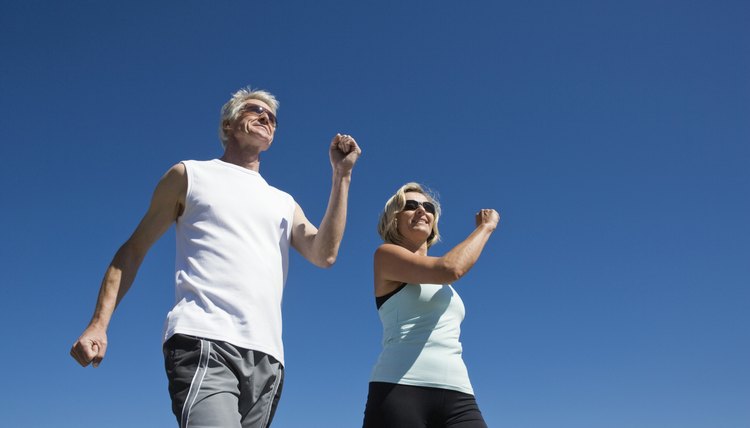What Muscles Does Walking Exercise?

Walking is one of the most common modes of exercise. A walking program can be tailored to any fitness level, and its low-impact nature makes it appropriate for nearly every age group. The American Council on Exercise notes that a regular walking program can improve your cholesterol, lower your blood pressure, improve bone strength, prevent weight gain and even boost your energy levels. Along with its many health benefits, walking also exercises several different muscles.
Quadriceps
The quadriceps, or quads, are a group of four muscles located on the front of your thigh and run from your hips and upper femur down to your knee cap. These muscles include the rectus femoris, vastus lateralis, vastus medialis and vastus intermedius. All four muscles work together to extend the knee while walking. The rectus femoris also acts to flex the hip, which is the movement necessary to lift your foot off the ground and prevent you from tripping as you step forward.
Hamstrings and Glutes
The biceps femoris, semitendinosus and semimembranosus make up the hamstring muscle group on the back of the thigh. These muscles work together to bend the knee of the leading leg while walking. The gluteal, or butt, muscles are located on the posterior hips. They include the gluteus maximus, gluteus medius and gluteus minimis. The gluteus maximus works with the hamstrings to extend the hip of the rear leg during a stride. Both of these muscles are worked more intensely when walking on an incline. The gluteus medius and minimus are exercised during walking by stabilizing the side of the pelvis that is not supported by a leg. For example, when you're stepping off your right leg, the gluteal muscles on the left side are activated to prevent that side of your hip from sagging.
Lower Leg
The tibialis anterior muscle of the lower leg is located anterior to the shin bone. This muscle is worked extensively while walking to lift your toes off the ground. The gastrocnemeus and soleus muscles make up the calf muscles on the back of the lower leg. These muscles are responsible for plantar flexion or lifting the heel. They are activated on the rear foot when pushing off the ground to propel yourself forward.
Upper Body
Though not targeted directly, several muscles in your upper body are exercised while walking. The abdominal muscles are used to support your torso as well as stabilize your pelvis while the muscles of your back work to maintain posture and keep your body in the upright position. Your shoulders are exercised continually as you swing your arms back and forth. Carry small hand weights to include your upper and lower arm muscles in this efficient full-body workout.
References
- ACE Get Fit: A Walk a Day
- ExRx.net: Quadriceps
- ACSM's Resources for the Personal Trainer, Second Edition; Nicki Anderson, et al
Writer Bio
Jen Weir writes for several websites, specializing in the health and fitness field. She holds a Bachelor of Science in exercise science from Montana State University, is an NSCA-certified strength and conditioning specialist and maintains a personal trainer certification from the American College of Sports Medicine.
